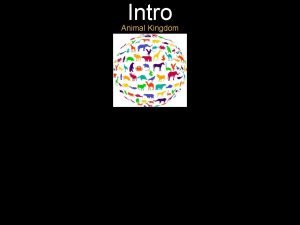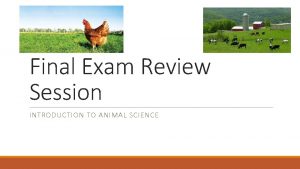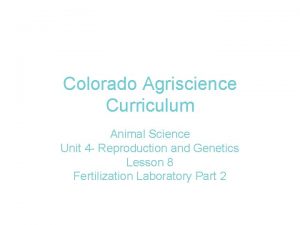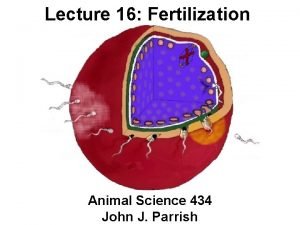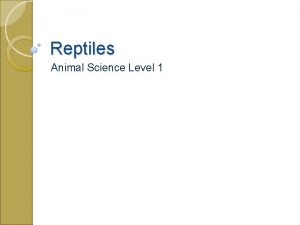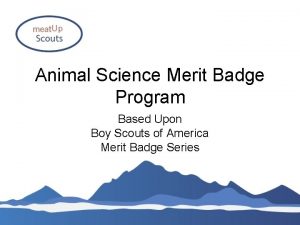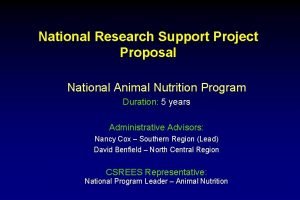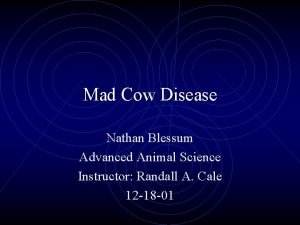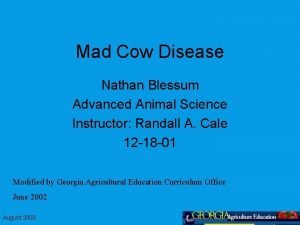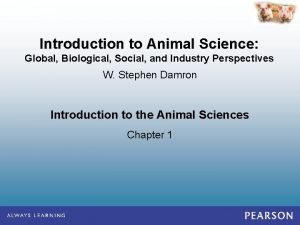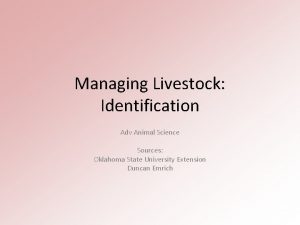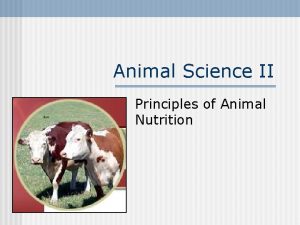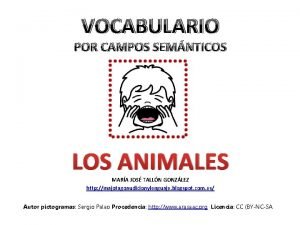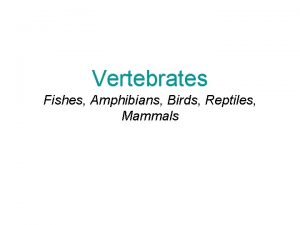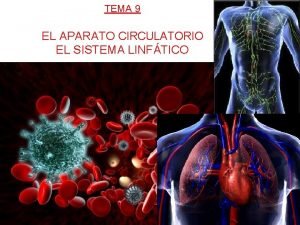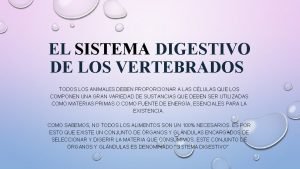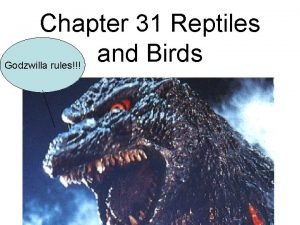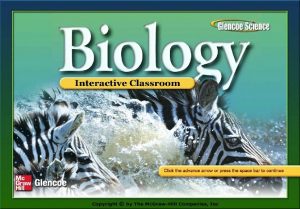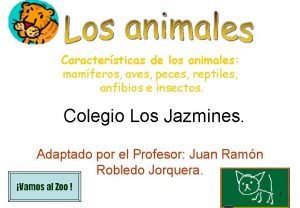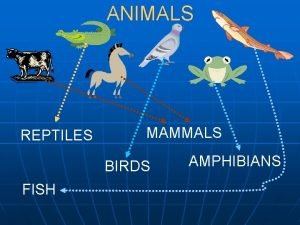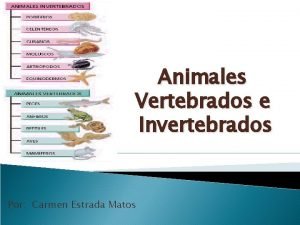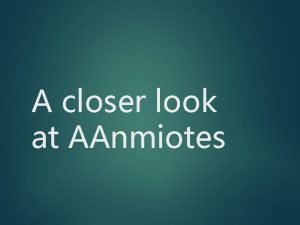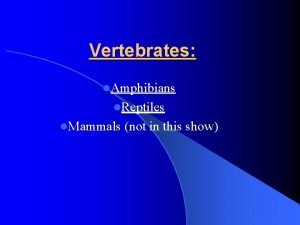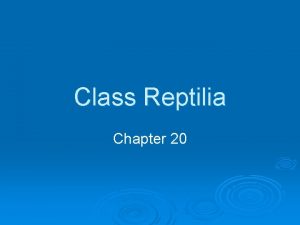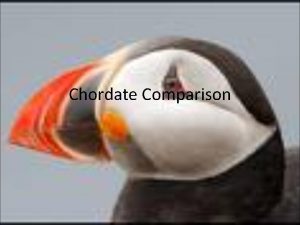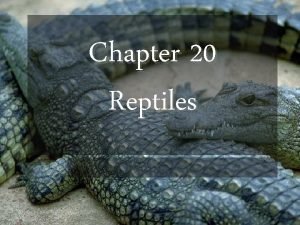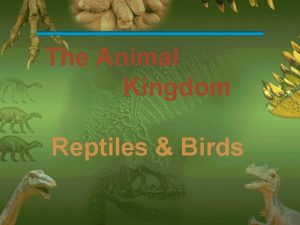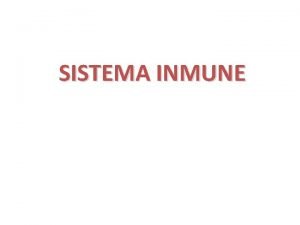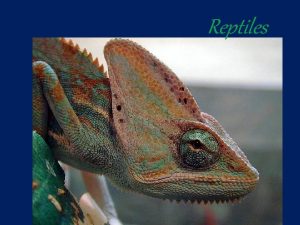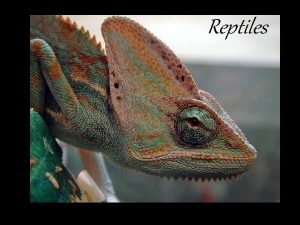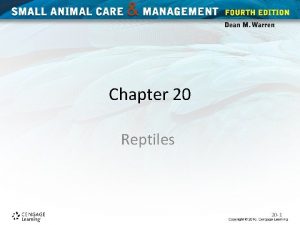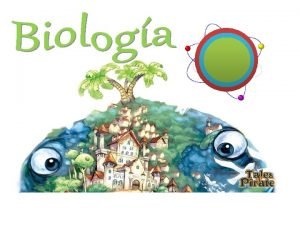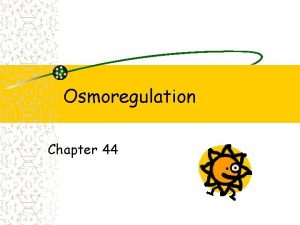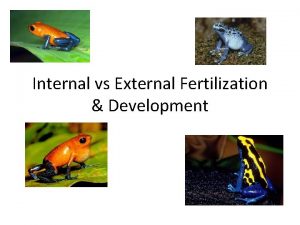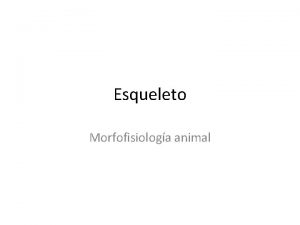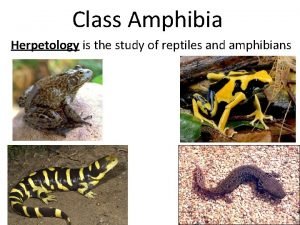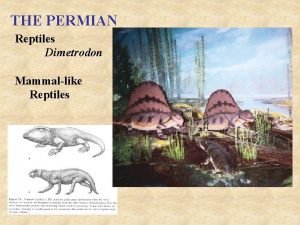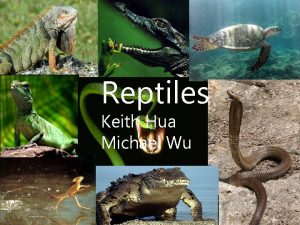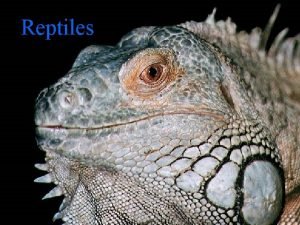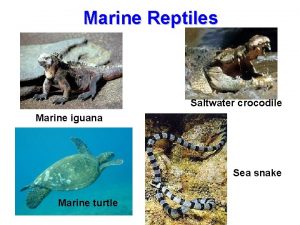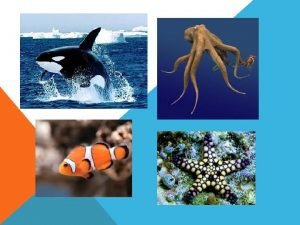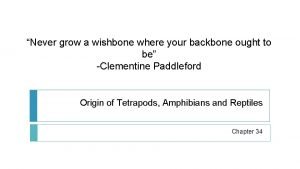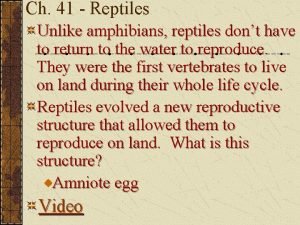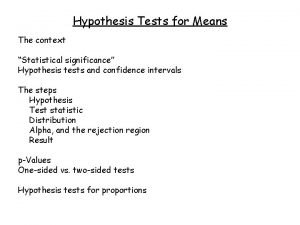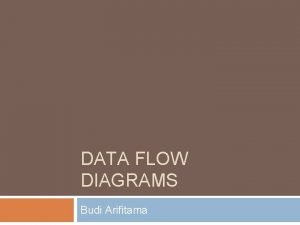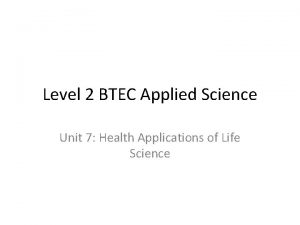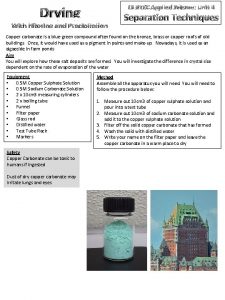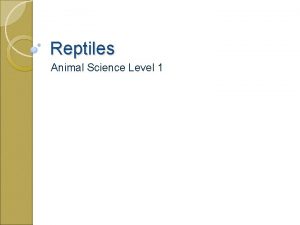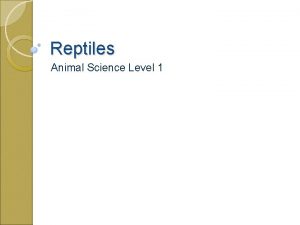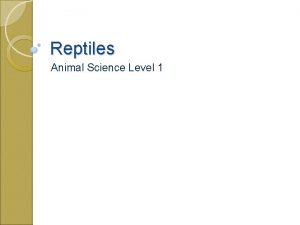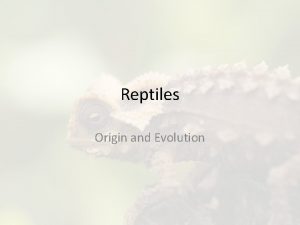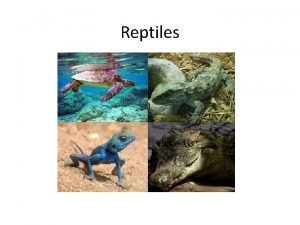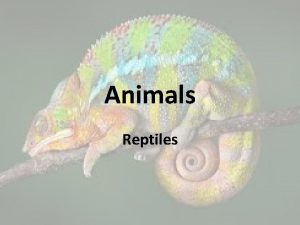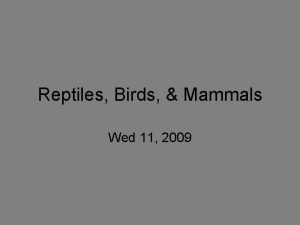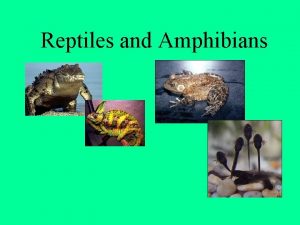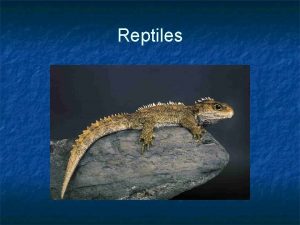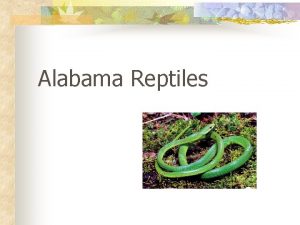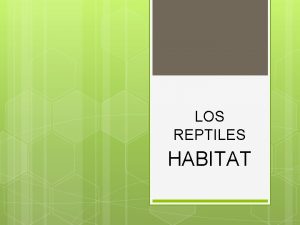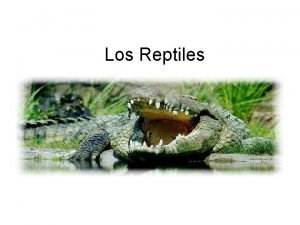Reptiles Animal Science Level 1 Intro to Reptiles


















































































- Slides: 82

Reptiles Animal Science Level 1

Intro to Reptiles Video: Pair Share to Follow (Part One Only)

Think Write Share THINK ◦ What makes a reptile? WRITE ◦ Your answer in 10 words or less SHARE ◦ With you face partner

Unit Map: Follow Along in your packet WHAT ARE YOU LEARNING? AS. 06. 02 Basic: Recognize, Identify, and Evaluate the effects of disease and parasites in animals AS. 03. 01: ID breeds and species

Know Understand Do! Know Types of reptiles Basic Care Requirements Gross internal and external anatomy Understand Requirements of differing types of species Proper care and disease prevention Physiology of reptiles Do Design a care guide Summarize care practices Analyze disease effects on Animals

Key Learning: Reptiles and Their Care Unit EQ: Why are reptiles growing in popularity? Concept : Types Lesson EQ: How are reptiles classified? Vocab Reptile, Tropical, Omnivore, Communal Concept : Care Lesson EQ: What is required for all reptile health? Vocab Furnishing, substrate, basking, UVB Concept : Anatomy Lesson EQ: How are reptiles suited for their environments? Vocab Impaction, Gout

Objectives Learn and Identify the common types of reptiles Understand behavioral characteristics of reptiles Identify and list habitat requirements

Warm Up Is this a reptile? Tell your partner Why/Why not?

Essential Question How are Reptiles Classified?

Graphic Organizer Animal Name/ Group Environment in which its found Basic Frog Wet, Near water, Tropical 4 Legs, Smooth Wet Skin, Life stages, Likes it humid Characteristics Basic Behavioral Traits Examples Hops, Nocturnal, Tree Frog

What is what? ? Put these on the TOP of your G. O. Reptile: any cold-blooded vertebrate of the class Reptilia including tortoises, turtles, snakes, lizards, alligators, crocodiles Amphibian: cold-blooded vertebrate typically living on land but breeding in water; aquatic larvae undergo metamorphosis into adult form

Frogs Types: Pacman, Green tree frog, Tomato frog, Dart frog (poisonous) For ages: 10 & up, with adult supervision Pet size: 2"- 4" long Habitat: tropical Behavior ◦ Insectivores ◦ Nocturnal ◦ Communal ◦ Good Climbers

Turtles: Semi- Aquatic Types: Red Eared Slider, Painted, Softshelled For ages: 12 & up, with adult supervision Pet lifespan: approximately 30 years Pet size: up to 12“ Behavior ◦ Omnivores ◦ Diurnal

Tortoises‘: Dry Land Types: Russian, Red footed, Greek For ages: 12 & up, with adult supervision Pet lifespan: approximately 50 year Pet size: up to 8“ Habitat: Temperate Behavior ◦ Herbivores ◦ Diurnal ◦ Burrow

Types: Snakes Corn, Ribbon, King For ages 12 and up with adult supervision Pet Lifespan: 5 years Pet Size: Dependent on type (3 ft) Behavior: ◦ Carnivores ◦ Nocturnal or Crepuscular ◦ Solitary ◦ Terrestrial-ground

Lizards: Desert Types: Bearded Dragon, Leopard Gecko, Mali Uromastyx For ages: 10 & up, with adult supervision Pet size: up to 10" long or larger Behavior ◦ Insectivores ◦ Nocturnal ◦ Solitary

Lizards: Tropical Types: Chinese Water Dragon, Iguana, Chameleon For ages: 14 & up, with adult supervision Pet lifespan: approximately 15 years Pet size: up to 36" long Behavior: ◦ Omnivores ◦ Diurnal ◦ Solitary

Think Write Share: Extension Question THINK ◦ What characteristics of reptiles would influence pet owner’s? 3 -5 Sentences Giving Examples WRITE ◦ 3 -5 Sentences Giving Examples SHARE ◦ With you face partner

Vocabulary: Closing Insectivore: Eat Insects Omnivore: Eat Fruit, Veggies, Meat and Bugs Herbivore: Only vegetables Nocturnal: Awake at night Diurnal: Awake during the day Communal: Like living together Tropical: Jungle like environment Temperate: Medium level heat, humidity and cool temperatures. Normally dry land Desert: Low to 0 humidity, high heat

Animals Around Us: Reptiles

Video Questions Complete after viewing

Activities Notes G. O. Extension Prompt Answered Video Questions Answered Take Home ◦ Design a care “Good Owner Wanted Ad” for an animal discussed Should be colored and include the information mentioned in your G. O. from today’s notes

Reptiles: Items for Care Animal Science Level 1

Take Home…. Get our your take home assignment and share with your partner. ◦ Discuss How would we provide this animal the best quality of life as a pet?

Objectives Learn proper reptile care Identify items needed to provide proper reptile environments

Warm-Up: Pair Share What does this animal need to survive?

Essential Question What is required for all reptile health?

Care: Areas of Focus Environment Food Water Illness Prevention Handling

Environment : Tropical Glass Tank (based on size of animal) ◦ Water proof because of high humidity Screen Lid for ventilation Substrate: ◦ Stones on bottom for drainage ◦ On top: moss, reptile bark, coconut husks or soil mixture MUST HOLD MOISTURE Basking sight (rock) Plants (live or fake) UVB or Florescent Lighting


Environment: Desert Glass Tank Screen lid for ventilation Substrate: ◦ Sand (be careful with feeding!) ◦ Newspaper Want to not hold moisture Basking sight UVB or Florescent lighting


Bearded Dragon Enclosure Set Up http: //www. articlesbase. com/videos/5 min/145449932

Environment: Turtles Glass Tank Screen lid for ventilation Water ◦ Treated for chlorine ◦ Heated (low heating requirements) ◦ FILTER Clean regularly Basking sight Plants (Live or Fake) UVB or Florescent lighting


Food Insectivores ◦ Crickets (live or dead) ◦ Worms (mealworms, wax worms, butter worms, ◦ Coat in Calcium dust (available at pet stores) Herbivores ◦ Dark leafy greens (WASHED) ◦ Fruit (without skins) ◦ Some calcium dust provided Carnivores ◦ Mice (live or frozen)

Water ALWAYS AVAILABLE! Bowls ◦ Easy to clean ◦ Keep free of mold Large water bowl ◦ Many reptiles shed ◦ They require full immersion in water for periods of time ◦ Water bowl must be able to fit the animal

Illness Prevention Keep water bowls clean Appropriate levels of humidity, and temperature to prevent to much mold growth Wash hands before and after handling ◦ Salmonella Proper Diet

Activities Using your Animal Science Books. ◦ Choose an animal Snake, Turtle, Frog, Lizard ◦ On the FRONT of your paper Where do you find your animal in the wild? Describe the habitat What does your animal eat? How does it “get” its food? What anatomical adaptations does your animal have that make it successful in its environment ◦ On the BACK of your paper for HW Design a “hero” poster for your animal. Include information from the front. Your poster must be colored

Think Write Share: Extension Question THINK ◦ What characteristic(s) of reptiles reflect their native environment? How do we meet their needs (from the wild) in a domesticated setting? WRITE ◦ 3 -5 Sentences Giving Examples SHARE ◦ With you face partner

Vocabulary: Substrate: bedding for reptiles, based on environmental needs of pet Furnishing: tank accessories, rocks, branches, live or fake Basking : sitting to gather sun: regulated temperature, required for Vitamin D UVB Lighting: artificial lighting to mimic the sun. Some provide both UV and UVB rays as well as heat

Life Science: Reptiles

After Viewing…. Think/Pair/Share ◦ How are reptiles and amphibians different?

Video Questions Complete after viewing

Activities Take Home ◦ Design a Habitat Choose any reptile/amphibian, Should be colored and include what items are present to help meet the “needs” of that animal (Extra Time)Amphibians Book Work page 361 ◦ Define all vocab, Answer the questions at end of chapter in complete sentences (Share Books)

Reptiles: Gross Anatomy Animal Science Level 1

Objectives Identify gross anatomy, and internal anatomy of common reptiles and amphibians

Warm Up: Think/Pair/Share How are these animals suited for their environment?

Essential Question How are reptiles suited for their environments?

Frog: Gross Anatom y

Frog Internal Anatomy

Turtle External Anatomy

Turtle: Internal

Snake: Internal and Skeletal Anatomy

Snake: Movement Represent these in your notes

Cool Creatures: Reptiles

Think Write Share: Extension Question THINK ◦ What characteristics of an environment effect the anatomy of reptiles/amphibians? Be able to give 2 examples WRITE ◦ 3 -5 Sentences Giving Examples SHARE ◦ With you face partner

Dissection Directions BEFORE STARTING Listen to ALL directions first TOUCH NOTHING DURING DISSECTION ◦ Each student will participate (in some manner) ◦ Round Robin reading of Directions ◦ 2 recorders of for discussion questions writing answers ◦ REMAIN SEATED ◦ Use all tools properly Assigned Jobs for AFTER Seat 1 – clean utensils Seat 2 - cleans dissection pad Seat 3 - wipes down table area

Activities Reptiles Book Work page 379 ◦ Define all vocab ◦ Use once in a sentence ◦ Answer the questions at end of chapter in complete sentences ◦ (Share Books)

Dirty Job’s Video Snake Wrangler ◦ Write down anatomical terms you hear and what they mean as we watch for review

Reptiles: Common Diseases Animal Science Level 1

Objectives Identify common characteristics of reptile and amphibian diseases Evaluate methods of treatment and prevention for reptile and amphibian diseases

Warm Up What is wrong with this reptile?

Essential Question What is the most effective method of prevention for reptile diseases?

Activity Read your handouts on different Reptile and amphibian common diseases at your table. (Please remember your number) Design a graphic organizer with your information ◦ What is it? Cause? Sign and Symptoms? Treatment? Prevention? You will present your information and graphic organizer to your classmates.

Station/Share Activity 1. all numbered students meet up with your group ◦ All the 1’s together, all the 2’s together etc 2. Gather information about your disease with your numbered group ◦ Fill in your graphic organizer notes 3. Return to you original seats (with a 1/2/3/4 student in all seats) 4. Share the information for your disease (should be at least 4 different diseases shared) ◦ ONE talk ALL write

Presentation s Graphic Organizers for notes

Common Reptile Diseases Gout Bladder Stones Mites Impaction

What is it? Gout ◦ Change in metabolism (usage and expulsion) of uric acid. Caused by too much of inappropriate proteins in reptile diets Signs ◦ Painful enlarged joints and kidneys due to build up of uric acid Treatment ◦ Dietary modification and maintenance Prevention ◦ Feed a balanced diet for your reptile.

Articular gout in lizard tail. Unable to move without pain

What is it? Bladder Stones ◦ Excess urates in bladder system crystallize forming stones Causes: ◦ Improper Diet and dehydration Signs: ◦ Rear leg paralysis or weakness, constipation, runny noses, egg-binding and lack of appetite Treatment: ◦ Removal of stone, adjustment in diet Prevention: ◦ Proper diet, plenty of water available

Bladder Stones in Tortoise

What is it? Mites ◦ Parasites: can lead to blood diseases Causes: ◦ Unclean living conditions, transmission from other reptiles Signs: ◦ Dysecdysis (difficulty shedding), extra time in water bowl Treatment: ◦ Clean entire cage to rid of mites, Prevention: ◦ Quarantine new animals, clean cages thoroughly, soak ornaments

Mite on Snake

What is it? ◦ Block in digestion tract Impaction Causes: ◦ Housing in loose substrate, inappropriate sized food, dehydration Signs: ◦ Constipation, bruising on abdomen, lethargy Treatment: ◦ Quarantine animal on paper towel, Take to vet if appetite doesn’t improve Prevention: ◦ Non-loose substrate, appropriate diet

Impaction in Lizard

Metabolic Bone Disease What is? ◦ improper calcium to phophorus ratio in the body Causes? ◦ No UV Light provided Signs ◦ Soft bones, tremors in the legs/tail Treatment ◦ Calcium provided + UV light (to metabolize Calcium)

Video MBD http: //www. youtube. com/watch? v=j 7 I hks. UVi. XI

Think Write Share: Extension Question THINK ◦ Why might reptile diseases be difficult to ID? WRITE ◦ 3 -5 Sentences Giving Examples SHARE ◦ With you face partner

Activities Complete you graphic organizers from your classmate’s presentations Design a brochure on reptile health for HW ◦ You have just covered many common reptile diseases. Make a brochure on how to keep a reptile healthy and free of these diseases based on what you have learned for prevention of these diseases. ◦ MUST BE COLORED

Video: Amphibians and Fish. Video quiz follows both segments

Test Review Define: Substrate, Basking, UVB, Furnishing, Insectivore, Herbivore, Carnivore, Desert, Temperate, Tropical, Omnivore, Nocturnal, Diurnal, Crespucular, Communal, Solitary Internal Anatomy of a Turtle Diagram Know the information the reptile diseases presented in class. Why are these diseases difficult to ID? What characteristics make reptiles good survivors? How are reptiles and amphibians different? How are reptiles suited for their environments? What is required for all reptile health? How do we meet these requirements? How are reptiles classified?
 Animal kingdom intro
Animal kingdom intro What's your favourite lesson
What's your favourite lesson Chapter 1 introduction to forensic science and the law
Chapter 1 introduction to forensic science and the law Venn diagram of plant and animal cells
Venn diagram of plant and animal cells Comparing plant and animal cells venn diagram
Comparing plant and animal cells venn diagram Animal rights versus animal welfare
Animal rights versus animal welfare Grade 11 life sciences animal nutrition
Grade 11 life sciences animal nutrition Animal science final exam
Animal science final exam Colorado animal science curriculum
Colorado animal science curriculum J
J Chinese water dragon anatomy
Chinese water dragon anatomy Animal science career cluster
Animal science career cluster Animal science merit badge worksheet
Animal science merit badge worksheet National animal nutrition program
National animal nutrition program Advanced animal science
Advanced animal science Advanced animal science
Advanced animal science Importance of animal science
Importance of animal science Adv animal science
Adv animal science Principles of animal science
Principles of animal science Campos semánticos de animales invertebrados
Campos semánticos de animales invertebrados Chordate cladogram
Chordate cladogram Circulación doble incompleta
Circulación doble incompleta Plane filling motif with reptiles
Plane filling motif with reptiles Animales vertebrados mamiferos aves peces anfibios reptiles
Animales vertebrados mamiferos aves peces anfibios reptiles Características de los artrópodos
Características de los artrópodos Sistema digestivo de las ranas
Sistema digestivo de las ranas Dinosaurs were reptiles that lived
Dinosaurs were reptiles that lived Chapter 31 reptiles and birds
Chapter 31 reptiles and birds Chapter 29 section 2 birds study guide answers
Chapter 29 section 2 birds study guide answers Chapter 29 section 1 reptiles
Chapter 29 section 1 reptiles Reptiles caracteristicas para niños
Reptiles caracteristicas para niños Amphibians reptiles mammals birds fish
Amphibians reptiles mammals birds fish Los sapos son invertebrados
Los sapos son invertebrados Different types of reptiles
Different types of reptiles Reptiles organs for locomotion
Reptiles organs for locomotion Porifera sistema digestivo
Porifera sistema digestivo Characteristics of reptilia
Characteristics of reptilia Reptiles organs for locomotion
Reptiles organs for locomotion Reptiles organs for locomotion
Reptiles organs for locomotion Reptiles order
Reptiles order Sistema inmune en reptiles
Sistema inmune en reptiles Reptiles order
Reptiles order Cyclemys dentata
Cyclemys dentata Physical features of reptiles
Physical features of reptiles Mediante tecnicas bioquimicas un biologo celular determino
Mediante tecnicas bioquimicas un biologo celular determino Reptiles animals
Reptiles animals Aves clasificación inferior
Aves clasificación inferior Internal vs external development
Internal vs external development El toyo
El toyo Amphibians and reptiles
Amphibians and reptiles Difference between reptiles and amphibians
Difference between reptiles and amphibians Saurichian
Saurichian Circulation in reptiles
Circulation in reptiles Fertilization in reptiles
Fertilization in reptiles Freshwater lizards
Freshwater lizards Reptiles carnivores
Reptiles carnivores Do reptiles show up on thermal imaging
Do reptiles show up on thermal imaging Synapsids
Synapsids Unlike amphibians reptiles
Unlike amphibians reptiles Molecular level vs cellular level
Molecular level vs cellular level Isis protocol
Isis protocol Significance and confidence level
Significance and confidence level Isis level 1 vs level 2
Isis level 1 vs level 2 What is the interpretation of a 96 confidence level
What is the interpretation of a 96 confidence level Confidence level and significance level
Confidence level and significance level Dfd level 0
Dfd level 0 Security level 0
Security level 0 Level one costa questions
Level one costa questions Thread level parallelism in computer architecture
Thread level parallelism in computer architecture Low-level thinking in high-level shading languages
Low-level thinking in high-level shading languages Poly foundation programme cut off
Poly foundation programme cut off Ocr a level computer science paper 1
Ocr a level computer science paper 1 Unit 7 btec applied science
Unit 7 btec applied science A level computer science exemplar candidate work
A level computer science exemplar candidate work Btec level 3 applied science unit 4 assignment b
Btec level 3 applied science unit 4 assignment b Computer science revision a level
Computer science revision a level Social science vs natural science
Social science vs natural science What are the branches of natural science
What are the branches of natural science Natural and physical science
Natural and physical science Applied science vs pure science
Applied science vs pure science Rapid change
Rapid change Think central science fusion
Think central science fusion Rule of 70 population growth
Rule of 70 population growth
